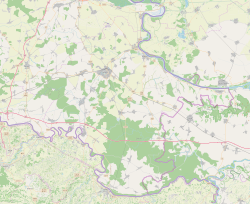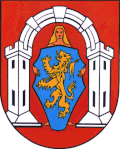Sotin
 From Wikipedia - Reading time: 9 min
From Wikipedia - Reading time: 9 min
Sotin | |
|---|---|
 | |
| Coordinates: 45°17′42″N 19°05′49″E / 45.295°N 19.097°E | |
| Country | |
| County | Vukovar-Syrmia County |
| Area | |
• Total | 23.0 km2 (8.9 sq mi) |
| Population (2021)[2] | |
• Total | 597 |
| • Density | 26/km2 (67/sq mi) |
| Demonym(s) | Sotinjanin (♂) Sotinjanka (♀) (per grammatical gender) |

Sotin is a village in eastern Croatia, located a few kilometers southeast of Vukovar by the Danube. It is administratively part of the city of Vukovar, and its population is 597 (census 2021).[3] The post code for Sotin is 32232 Sotin.
History
[edit]One Scordisci archaeological site dating back to late La Tène culture was excavated in the 1970s and 1980s as a part of rescue excavations in eastern Croatia.[4]
Sotin (German Sotting, Hungarian Szottin) was first mentioned in 1289 as a fortress of the Vukovar jobagions. In Sotin, there is an archaeological site with a settlement of the Pannonian Kornakata tribe. Archaeological finds speak of life in the Sotin area from the Copper Age to the Younger Iron Age and the Celtic Skordisks. [5]
Croatian War of Independence
[edit]During the Croatian War of Independence, 32 residents of Sotin were killed and another 32 are missing as of 2013[update]. A mass grave containing three bodies was discovered near the village through information obtained by Serbian authorities conducting a criminal inquest of war crimes—killing of 16 Croatian civilians in Sotin—committed by the Croatian Serb militia and Territorial Defense Forces in late 1991.[6] In April 2013, the second mass grave was found in the village. It contained ten bodies transferred from the mass grave containing the three other bodies to a village slaughterhouse pit where animal bones were disposed of at the time. The move was made in 1997 in order to hide the bodies better. All thirteen, whose remains were found in the two graves, were killed on 26 December 1991.[7] Two other mass graves were found previously, one at the Catholic graveyard in the village and the other in nearby vineyards.[8]
References
[edit]- ^ Register of spatial units of the State Geodetic Administration of the Republic of Croatia. Wikidata Q119585703.
- ^ "Population by Age and Sex, by Settlements" (xlsx). Census of Population, Households and Dwellings in 2021. Zagreb: Croatian Bureau of Statistics. 2022.
- ^ "Population by Age and Sex, by Settlements, 2011 Census: Sotin". Census of Population, Households and Dwellings 2011. Zagreb: Croatian Bureau of Statistics. December 2012.
- ^ Dizdar, Marko (2016). "Late La Tène Settlements in the Vinkovci Region (Eastern Slavonia, Croatia): Centres of Trade and Exchange" (PDF). Boii - Taurisci: Proceedings of the International Seminar, Oberleis-Klement, June 14th-15th, 2012. Austrian Academy of Sciences Press: 31–48. Retrieved 22 January 2019.
- ^ "Sotin". www.enciklopedija.hr. Retrieved 2022-11-24.
- ^ "U masovnoj grobnici kod Sotina pronađena tri tijela" [Three bodies found in a mass grave near Sotin] (in Croatian). tportal.hr. 19 April 2013.
- ^ Branimir Bradarić (24 April 2013). "Završeni radovi na dvije masovne grobnice u Sotinu" [Survey of two mass graves in Sotin completed]. Večernji list (in Croatian).
- ^ Sanja Butigan (20 April 2013). "Grobnica žrtava iz Sotina premještana 1997. zbog pokušaja skrivanja tragova" [Mass Grave of Sotin Victims Moved in 1997 in an Attempt to Hide Evidence]. Glas Slavonije (in Croatian).
 KSF
KSF



